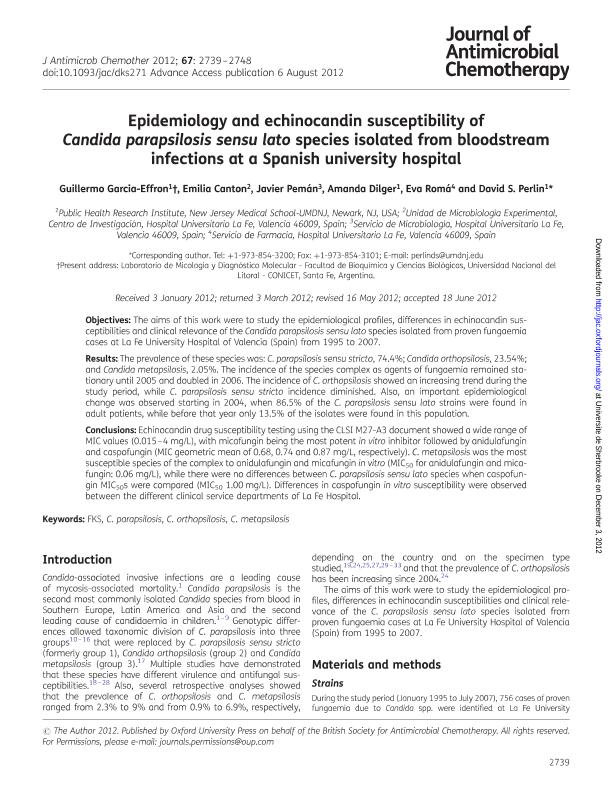Artículo
Epidemiology and echinocandin susceptibility of Candida parapsilosis sensu lato species isolated from bloodstream infections at a Spanish University Hospital
Garcia, Guillermo Manuel ; Canton, Emilia; Pemán, Javier; Dilger, Amanda; Romá, Eva; Perlin, David S.
; Canton, Emilia; Pemán, Javier; Dilger, Amanda; Romá, Eva; Perlin, David S.
 ; Canton, Emilia; Pemán, Javier; Dilger, Amanda; Romá, Eva; Perlin, David S.
; Canton, Emilia; Pemán, Javier; Dilger, Amanda; Romá, Eva; Perlin, David S.
Fecha de publicación:
11/2012
Editorial:
Oxford University Press
Revista:
Journal of Antimicrobial Chemotherapy
ISSN:
0305-7453
Idioma:
Inglés
Tipo de recurso:
Artículo publicado
Clasificación temática:
Resumen
Objectives: The aims of this work were to study the epidemiological profiles, differences in echinocandin susceptibilities and clinical relevance of the Candida parapsilosis sensu lato species isolated from proven fungaemia cases at La Fe University Hospital of Valencia (Spain) from 1995 to 2007.The aims of this work were to study the epidemiological profiles, differences in echinocandin susceptibilities and clinical relevance of the Candida parapsilosis sensu lato species isolated from proven fungaemia cases at La Fe University Hospital of Valencia (Spain) from 1995 to 2007. Results: The prevalence of these species was: C. parapsilosis sensu stricto, 74.4%; Candida orthopsilosis, 23.54%; and Candida metapsilosis, 2.05%. The incidence of the species complex as agents of fungaemia remained stationary until 2005 and doubled in 2006. The incidence of C. orthopsilosis showed an increasing trend during the study period, while C. parapsilosis sensu stricto incidence diminished. Also, an important epidemiological change was observed starting in 2004, when 86.5% of the C. parapsilosis sensu lato strains were found in adult patients, while before that year only 13.5% of the isolates were found in this population. Conclusions: Echinocandin drug susceptibility testing using the CLSI M27-A3 document showed a wide range of MIC values (0.015?4 mg/L), with micafungin being the most potent in vitro inhibitor followed by anidulafungin and caspofungin (MIC geometric mean of 0.68, 0.74 and 0.87 mg/L, respectively). C. metapsilosis was the most susceptible species of the complex to anidulafungin and micafungin in vitro (MIC50 for anidulafungin and micafungin: 0.06 mg/L), while there were no differences between C. parapsilosis sensu lato species when caspofungin MIC50s were compared (MIC50 1.00 mg/L). Differences in caspofungin in vitro susceptibility were observed between the different clinical service departments of La Fe Hospital.Echinocandin drug susceptibility testing using the CLSI M27-A3 document showed a wide range of MIC values (0.015?4 mg/L), with micafungin being the most potent in vitro inhibitor followed by anidulafungin and caspofungin (MIC geometric mean of 0.68, 0.74 and 0.87 mg/L, respectively). C. metapsilosis was the most susceptible species of the complex to anidulafungin and micafungin in vitro (MIC50 for anidulafungin and micafungin: 0.06 mg/L), while there were no differences between C. parapsilosis sensu lato species when caspofungin MIC50s were compared (MIC50 1.00 mg/L). Differences in caspofungin in vitro susceptibility were observed between the different clinical service departments of La Fe Hospital.
Palabras clave:
C. METAPSILOSIS
,
C. ORTHOPSILOSIS
,
C. PARAPSILOSIS
,
FKS
Archivos asociados
Licencia
Identificadores
Colecciones
Articulos(CCT - SANTA FE)
Articulos de CTRO.CIENTIFICO TECNOL.CONICET - SANTA FE
Articulos de CTRO.CIENTIFICO TECNOL.CONICET - SANTA FE
Citación
Garcia, Guillermo Manuel; Canton, Emilia; Pemán, Javier; Dilger, Amanda; Romá, Eva; et al.; Epidemiology and echinocandin susceptibility of Candida parapsilosis sensu lato species isolated from bloodstream infections at a Spanish University Hospital; Oxford University Press; Journal of Antimicrobial Chemotherapy; 67; 11; 11-2012; 2739-2748
Compartir
Altmétricas



